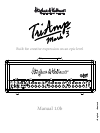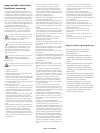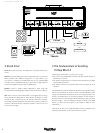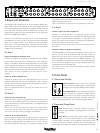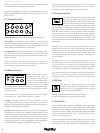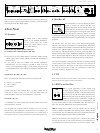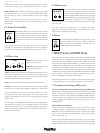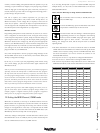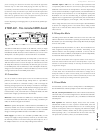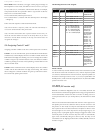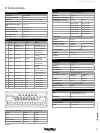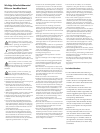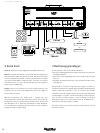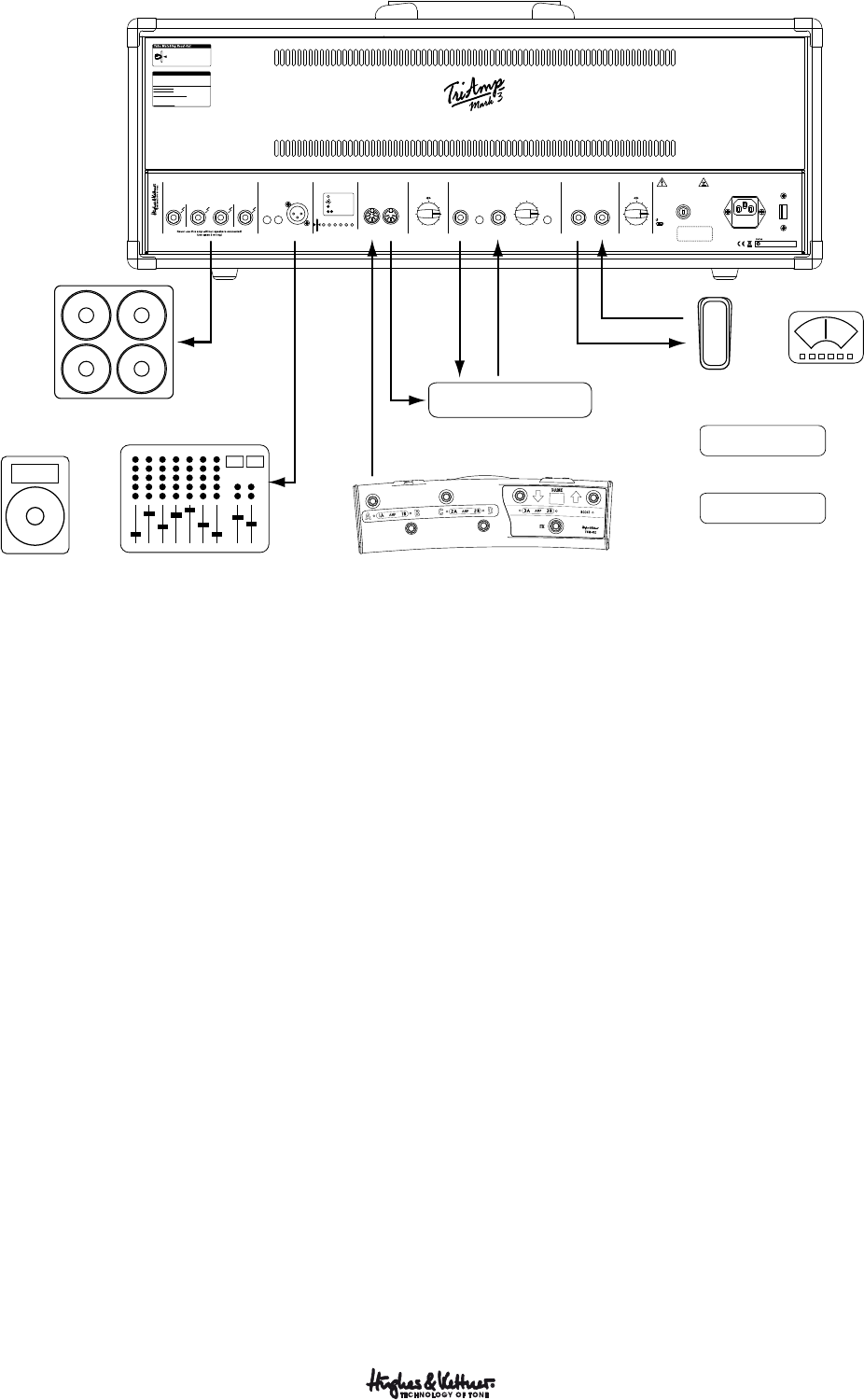
4
TriAmp Mark 3 – Manual 1.0b
2 Quick Start
Mains In: Connect the factory-included power cord (Mains Lead) to this
socket.
MIDI In: Connect the MIDI Out of the included TSM-432 or your favorite
MIDI controller to the MIDI In. Though this is a 7-pin interface, you
can connect a standard 5-pin MIDI cable and use any standard MIDI
controller. The two additional terminals (1 and 7) serve to supply phantom
power to the Hughes & Kettner TSM-432 MIDI board.
Speaker: Connect a speaker cabinet designed for guitar amps. We
recommend the matching Hughes & Kettner TM and TC Series cabinets.
AES: The EU version of the TriAmp Mark 3 is equipped with an energy
saving mechanism called AES (for more details, see Chapter 8 of this
manual). If AES is activated (as it is by default in the factory settings),
the TriAmp will automatically be switched off after a phase of silence or
inactivity of about 90 minutes. The phase of silence is reset as soon as it
receives an input signal.
3 The fundamentals of handling
TriAmp Mark 3
Operating the TriAmp Mark 3 is as easy as it can get:
• There are six fully independent channels, and each channel features an
identical set of controls.
• The position of each button is connected to the channel and is recalled
with the selected channel.
• The Master controls on the left-hand side of the front panel affect all
channels.
The Stomp Boost and Power Amp Tubes buttons look like global settings,
but they can actually be set for each of the six channels separately. These
settings are memorized automatically when you change channels. This
means, for example, that if you are playing Channel 1A with one pair of
6L6 tubes, Boost on, these settings will be recalled every time you select
channel 1A again – until you change the settings. (With the use of MIDI
Presets, you have even more options – see Chapter 5, MIDI, for more
information.)
The buttons all also serve as indicator LEDs, and they illuminate when
selected to call attention to the active channel or function.
FX-Unit
FX-Unit
Power Amp
Vol. Pedal
Mixing Desk
Powered
Cabinet
Guitar Cabinet
Tuner
or
or
or
or
TSM-432
=e
=e
,<]LYZPVUVUS`
VUVMM
(,:
;VYLK\JL[OLYPZRVMLSLJ[YPJZOVJRNYV\UKPUNVM
[OLJLU[LYWPUVM[OPZWS\NT\Z[ILTHPU[HPULK
9LWSHJPUNM\ZLZT\Z[VUS`ILJHYYPLKV\[I`
X\HSPMPLKZLY]PJLWLYZVUULS9LWSHJLM\ZLZVUS`
^P[O[`WLHUKYH[PUNZOV^UOLYL
*(<;065!9PZRVMLSLJ[YPJ
ZOVJR+VUV[VWLU9LMLY
ZLY]PJPUN[VX\HSPMPLK
ZLY]PJLWLYZVUULS
*(<;065!9LHYWHULSHUK
]LU[PSH[PVUVWLUPUNZTH`
ILJVTL[VVOV[[V[V\JO
3LH]LLUV\NOZWHJLMVY
WYVWLY]LU[PSH[PVU
4HPUZ-\ZL!=;(3/a
4H_7V^LY*VUZ\TW[PVU>
;VKVHTHU\HSYLHKV\[VM[OL[\IL
TH[JOPUNPUZLY[HWPJRPU[V[OLZSV[
HUKJV\U[[OLMSHZOLZVMLHJO3,+
;OLKPMMLYLUJLPUMSHZOLZZOV\SKIL
SLZZ[OHU^P[OPULHJOWHPY[V
N\HYHU[LLILZ[ZV\UK7SLHZLYLMLY
[V[OLTH[JOPUNJOHY[PU[OLTHU\HS
;:*H\[VTH[PJHSS`PUKPJH[LZ[OLZ[H[\ZVM[OL[\ILZ
HZZVVUHZ[OLHTWPZPUWSH`TVKL:;(5+)@Z^P[JO
PU\WWLYWVZP[PVU0M[OL3,+ZZ[H`VUPUWSH`TVKL
WSLHZLJOLJR[OLHUVKLM\ZL
(SS3,+ZVMMTLHUZ!ILZ[IPHZUVYTHSVWLYH[PVU
6UL3,+VUTLHUZ!UVJ\YYLU[[\ILPZIYVRLUHUK
OHZ[VILYLWSHJLK
6UL3,+MSHZOLZVUL3,+PZVU![OLMSHZOPUN3,+
PUKPJH[LZH[\IL[OH[JH\ZLZV]LYJ\YYLU[[OLV[OLY
3,+PUKPJH[LZHZ^P[JOLKVMM[\IL[VWYV[LJ[[OLHTW
7SLHZLYLWSHJL[OL[\IL[OH[JH\ZLZV]LYJ\YYLU[
;^V3,+ZVUTLHUZ!WHPYVM[\ILZPZZ^P[JOLKVMM
Tube Status Monitor
MADE IN GERMANY
7V^LY;\ILZ!
Ambience emulated DI Out
In
TSM-432
Out/Thru Send Return Preamp Out Power Amp In
FX Level
Anode Fuse
=;T(3
4HPUZ=VS[HNL
¶K)
FX Serial
SoftHard
RED BOX
™
AE TSC
™
MIDI NOISE GATE FX LOOP MASTER INSERT PANELSPEAKERS
1x 8 Ohms
or 2x 16 Ohms
4 Ohms16 Ohms
BrightDark
Serial No.
0UZLY[N\P[HYWPJR[VYLHK
V\[[\ILTH[JOPUN
V]LYJ\YYLU[
UVJ\YYLU[
Z^P[JOLKVMM
ILZ[)PHZ
7V^LY(TW;\ILZ
3V^
*\[
*HIPUL[
4VKL
;90(474HYR



